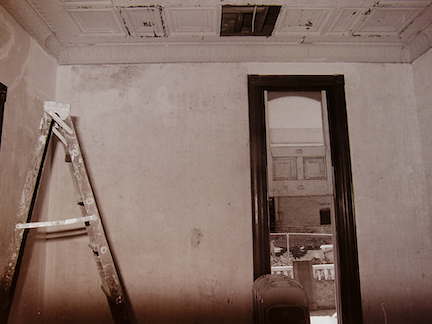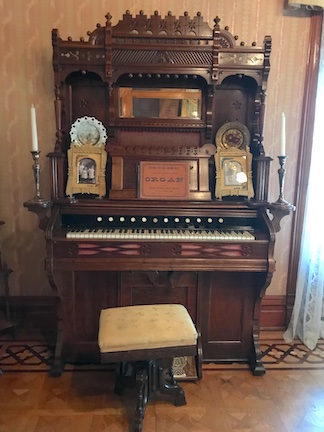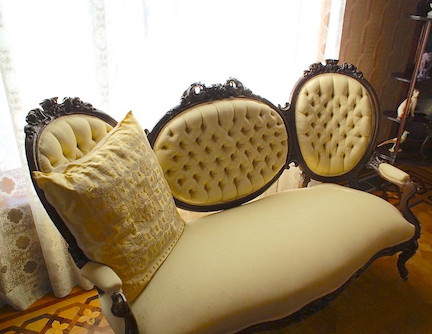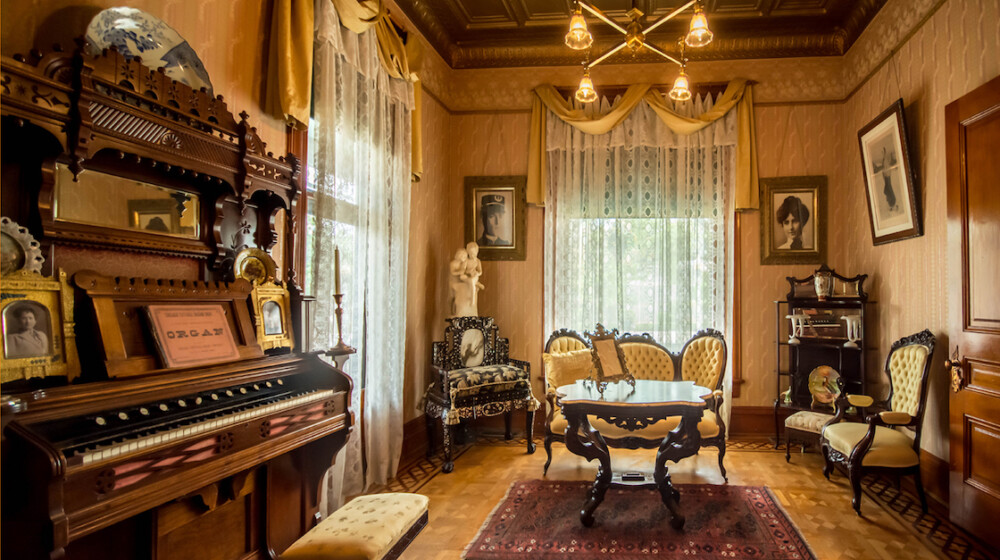Formal Parlor
 In an interview with Jessie Jean (Higley) Lane, she recalls that her mother’s wedding photo was displayed on the north wall of the parlor in an ornate gold frame. She also recalls large lace curtains hanging over the beveled glass picture window, which is original to the home. The picture window is covered with Plexiglas to help keep it safe (completed during restoration of Rosson House). The ruby glass transom over the parlor door to the foyer is original to the house.
In an interview with Jessie Jean (Higley) Lane, she recalls that her mother’s wedding photo was displayed on the north wall of the parlor in an ornate gold frame. She also recalls large lace curtains hanging over the beveled glass picture window, which is original to the home. The picture window is covered with Plexiglas to help keep it safe (completed during restoration of Rosson House). The ruby glass transom over the parlor door to the foyer is original to the house.
Sometime after the Gammel family sold the Rosson House in 1948, the pocket doors between this room and the dining room were enclosed, separating the two rooms. When they were discovered during restoration, they were used as a guideline for the color of the woodwork in the remainder of the house. The restored finish is orange shellac and was covered with a coat of varnish, which is not correct to the time period, but it was added to protect the wood. The windows in the pocket doors are not original to the house, and likely date to the 1940s. Marks on the door frames indicate that a curtain or a portiere was hung between the parlor and the dining room.
When the home was a boarding house, the front porch on this side was enclosed and a kitchen and bathroom added on, along with an exterior door and stairs (all later removed during restoration). The vertical pocket door in this room would have accessed that area.
There are a few interesting artifacts in this room that visitors want to know more about. Here are a few of our favorites, in alphabetical order (if there are any we’ve missed that you’d like to know more about, please let us know):
-
Engraving
Engraving by J. B. Hunt, dated 1881. Entitled Priscilla, this engraving was based on a painting by G.H. Boughton, a Victorian Era artist who specialized in American art from the colonial period.
-
Organ
 Eastlake style pedal organ (circa 1890) made from walnut and manufactured by “Chicago Cottage Organ Company, Chicago, Ill.” Stenciled number on back “S. 36. 98858”. The original cost of this organ is unknown, but a similar style of organ made by a different company was sold in the 1894 Sears and Roebuck catalog for $47.90 (which is over $1,600 today, adjusting for inflation).
Eastlake style pedal organ (circa 1890) made from walnut and manufactured by “Chicago Cottage Organ Company, Chicago, Ill.” Stenciled number on back “S. 36. 98858”. The original cost of this organ is unknown, but a similar style of organ made by a different company was sold in the 1894 Sears and Roebuck catalog for $47.90 (which is over $1,600 today, adjusting for inflation). -
Settee and Armchair
 Belter-style, Rococo Revival settee or loveseat and matching armchair, made of walnut and with a button-tufted back and Walnut and padded inset arms. Furniture in this style was popular in formal parlors, and is characterized by curved, cabriole legs, strong C- and S-curves and scrolls, and the use of carved ornaments, particularly flowers. The yellow upholstery is not original.
Belter-style, Rococo Revival settee or loveseat and matching armchair, made of walnut and with a button-tufted back and Walnut and padded inset arms. Furniture in this style was popular in formal parlors, and is characterized by curved, cabriole legs, strong C- and S-curves and scrolls, and the use of carved ornaments, particularly flowers. The yellow upholstery is not original. -
Whatnot or Étagère
This Eastlake style shelving unit is made from walnut, machine made, and dates back to about 1890. It is one of the few items in our collection that belongs to one of the families to live in Rosson House – in this case, the Goldberg family. The donor indicated that this piece was on display in the house when the Goldbergs lived here.
Learn more about Rosson House’s pressed metal ceilings, windows, and parquet wood floors from our blog articles, So Metal, A Glass Act, and Fancy Floors. Explore the history of ordering construction materials through mail-order by reading our blog article, Mail-Order Hardware & Houses.
El Salón Formal
 En una entrevista con Jessie Jean (Higley) Lane, ella recuerda la fotografía de bodas de su madre adornaba la pared norte del salon con su vistoso marco dorado. También recuerda largas cortinas de encaje que colgaban sobre el ventanal de video biselado, el cual es original a la casa. En ventanal está cubierto por plexiglas para mantenerlo a salvo (lo cual se llevó acabo durante la restauración de la Casa Rosson). La ventana de popa de vidrio rub que se encuentra sobre la puerta del salón es original a la casa.
En una entrevista con Jessie Jean (Higley) Lane, ella recuerda la fotografía de bodas de su madre adornaba la pared norte del salon con su vistoso marco dorado. También recuerda largas cortinas de encaje que colgaban sobre el ventanal de video biselado, el cual es original a la casa. En ventanal está cubierto por plexiglas para mantenerlo a salvo (lo cual se llevó acabo durante la restauración de la Casa Rosson). La ventana de popa de vidrio rub que se encuentra sobre la puerta del salón es original a la casa.
Tiempo después de que la familia Gammel vendió la Casa Rosson en 1948, las puertas corredizas entre esta habitación y el comedor fueron bloqueadas, separando los dos espacios. Cuando se descubrieron durante la restauración, fueron utilizadas como guía para el color de la carpintería del resto de la casa. El acabado restaurado es de un color de laca anaranjado y fue cubierto con una capa de barniz, la cual no es correcto para el periodo histórico, pero se agregó para proteger la madera. Las ventanas en las puertas corredizas no son originales a la casa, y probablemente datan de los 1940s. Marcas en los marcos de las puertas indican que una cortina o partición colgaba entre el salón y el comedor.
Cuando la casa fue una casa de huéspedes, el porche delantero de este lado estaba cerrado y se le agregaron una cocina y un baño, al igual que una puerta exterior y escaleras (todo fue removido durante la restauración). La puerta corrediza vertical en este cuarto hubiera tenido acceso a esa área.
Hay algunos artefactos interesantes en esta habitación de los cuales los visitantes quisieran saber más. Aquí están algunos de nuestros favoritos, en orden alfabético (si hay alguno que ha faltado del cual quisieras saber más, háznoslo saber):
-
Grabado
Grabado por J. B. Hunt, con fecha de 1881. Titulado Priscilla, este grabado está basado en una pintura de G.H. Boughton, un artista de la Época Victoriana quien se especializó en arte Americano del periodo colonial.
-
Étagère o Estante de Cositas
Este estante de estilo Eastlake fue fabricada en nogal, fue hecho a máquina, y data de alrededor de 1890. Es uno de los pocos objetos en nuestra colección que pertenece a una de las familias que vivieron en la Casa Rosson – en este caso, la familia Goldberg. El donante indicó que esta pieza se mostraba en la casa mientras los Goldbergs vivían ahí.
-
Órgano
 Órgano de pedal estilo Eastlake (de alrededor del año 1890), hecho de nogal y fabricado por “Chicago Cottage Organ Company, Chicago, Ill.” Tiene los números “S. 36. 98858” en la parte trasera. El costo original de este órgano se desconoce, pero un órgano de estilo similar hecho por otra compañía fue vendido el el catálogo de Sears y Roebuck de 1894 por $47.90 (lo cual es más de $1,600 el día de hoy, ajustado por inflación).
Órgano de pedal estilo Eastlake (de alrededor del año 1890), hecho de nogal y fabricado por “Chicago Cottage Organ Company, Chicago, Ill.” Tiene los números “S. 36. 98858” en la parte trasera. El costo original de este órgano se desconoce, pero un órgano de estilo similar hecho por otra compañía fue vendido el el catálogo de Sears y Roebuck de 1894 por $47.90 (lo cual es más de $1,600 el día de hoy, ajustado por inflación). -
Silla y Sillón
 Sillón con estilo Belter y de renacimiento Rococó con juego de sillón, fabricado en nogal y con respaldo abotonado y brazos acolchados de nogal. Muebles de este estilo eran populares en los salones formales, y se caracterizan por sus patas cabriolé, ondas y curvas en C y S, y el uso de tallados ornamentales, particularmente de flores. La tapicería amarilla no es original.
Sillón con estilo Belter y de renacimiento Rococó con juego de sillón, fabricado en nogal y con respaldo abotonado y brazos acolchados de nogal. Muebles de este estilo eran populares en los salones formales, y se caracterizan por sus patas cabriolé, ondas y curvas en C y S, y el uso de tallados ornamentales, particularmente de flores. La tapicería amarilla no es original.
Aprende más acerca de la Casa Rosson y sus techos de metal prensado, ventanas, y suelos de parquet de madera de nuestros artículos de blog So Metal, A Glass Act (Actuación de v, y Fancy Floors (pisos elegantes). Explora la historia detrás de ordenar materiales de construcción por correo leyendo nuestro artículo de blog, Casas y materiales por correo.
Siguiente Página: The Dining Room Volver a la Página Principal
